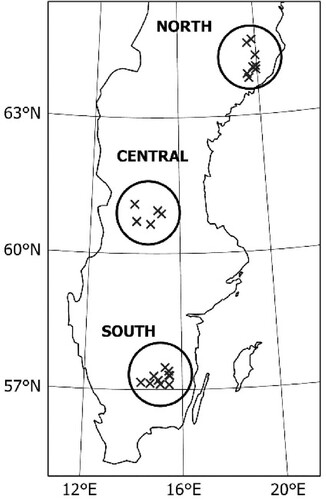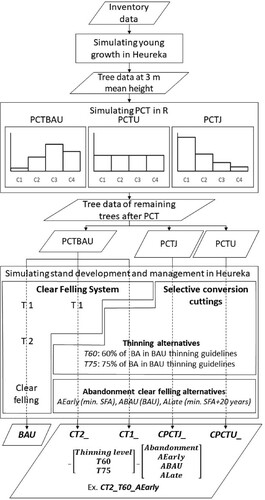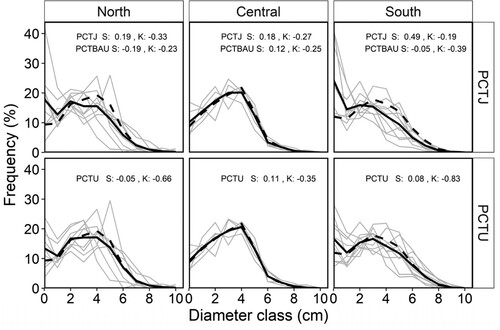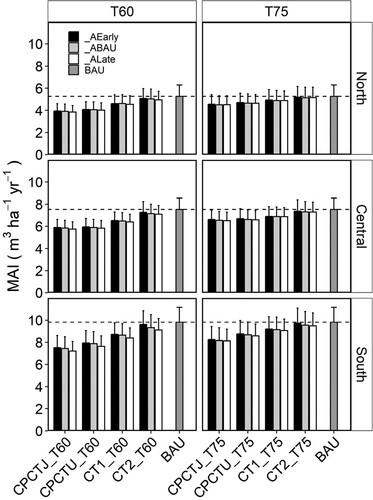Figures & data
Figure 1. Location of the inventoried stands used as input to the simulation. The three clusters of stands were located in northern (9 stands), central (5 stands) and southern Sweden (10 stands).

Table 1. Stand characteristics of the inventoried regenerations used as input to the simulations. Height is the arithmetic mean tree height. Height and tree species distribution refers to the total number of stems.
Figure 2. The structure of the scenario simulation. Pre-commercial thinning aimed at leaving larger trees (PCTBAU), a uniform distribution (PCTU) or an inverse J-shaped distribution (PCTJ). The scenarios simulated in Heureka were traditional management (BAU) with two commercial thinnings (CT 1, CT 2) and clear felling, conversion to selection forestry (SF) initiated at PCT (CPCTJ, CPCTU) or at the time of first (CT1) or second (CT2) commercial thinning in BAU. Scenarios for basal area after thinning were 75% (T75) and 60% (T60) compared to conventional guidelines (Skogsstyrelsen Citation1985a, Citation1989). Scenarios for abandonment of conversion forestry was continuous SF and clear felling at the same age as in BAU (ABAU), ending SF at minimum cutting age according to Swedish forestry act (SFA) and clear felling at max LEV (AEarly) and ending SF at minimum cutting age +20 years and clear felling at max LEV (ALate).

Figure 3. Diameter distribution after different conversion treatments at pre-commercial thinning (PCT). The distribution is presented for each stand (grey line) and as an average for each region (black solid line). In addition, the average diameter distribution after traditional PCT (black dashed line) is presented as a reference. The frequency refers to the relationship between the stem number in each class and the total number of stems. Average skewness (S) and kurtosis (K) is presented for each treatment and region. For abbreviations of PCT alternatives, see .

Figure 4. Diameter distribution for each region and conversion strategy at the time of final felling in abandonment scenario ABAU. Average (black solid line) and stand-wise (grey solid line) distributions are presented for selection cutting scenarios T60. Average distribution is also presented for selection cutting scenarios T75 (dashed line) and traditional BAU (dotted line). The frequency refers to the proportion of the total stem number within each diameter class. For abbreviations of conversion strategies, see .

Table 2. Characteristics of thinnings, selection cuttings and rotation length for each scenario, abandonment option and interest rate over the period from start of simulation to time of final felling. Average is presented for number of conventional thinnings or selection cuttings (N), basal area before (Bbef, m2 ha−1) and after (Baft, m2 ha−1) removal and rotation length (RL, year). For abbreviations of scenarios and abandonment options, see .
Figure 5. Mean annual volume growth for different abandonment options AEarly (black), ALate (white) and ABAU (grey). In addition, the volume production of a traditional clear-cutting system (BAU) is presented (dark grey bar, dashed line). Volume production was calculated separately for stands located in northern, central and southern Sweden and for selection cutting scenarios T60 and T75. Simulations were based on an interest rate of 2%. For abbreviations of strategies and scenarios, see .

Figure 6. Land expectation value at the time of establishment for different conversion strategies and for the abandonment options AEarly (black), ALate (white) and ABAU (grey). The dashed lines represent LEV of a traditional clear-cutting system (BAU). LEV was calculated as a mean for stands located in northern, central and southern Sweden, using interest rates of 1%, 2% and 3%. For abbreviations of strategies and scenarios, see .

Table 3. Volume of pulpwood and timber and quadratic mean diameter (Dg) at harvest in abandonment option ABAU in relation to a clear-felling system (BAU, 100%) at simulations using 2% interest rate. Separate figures are presented for final felling and for the total removal from the start of the simulation until final felling. For abbreviations of conversion scenarios, see .
Data availability
Data are available upon request from the corresponding author.
